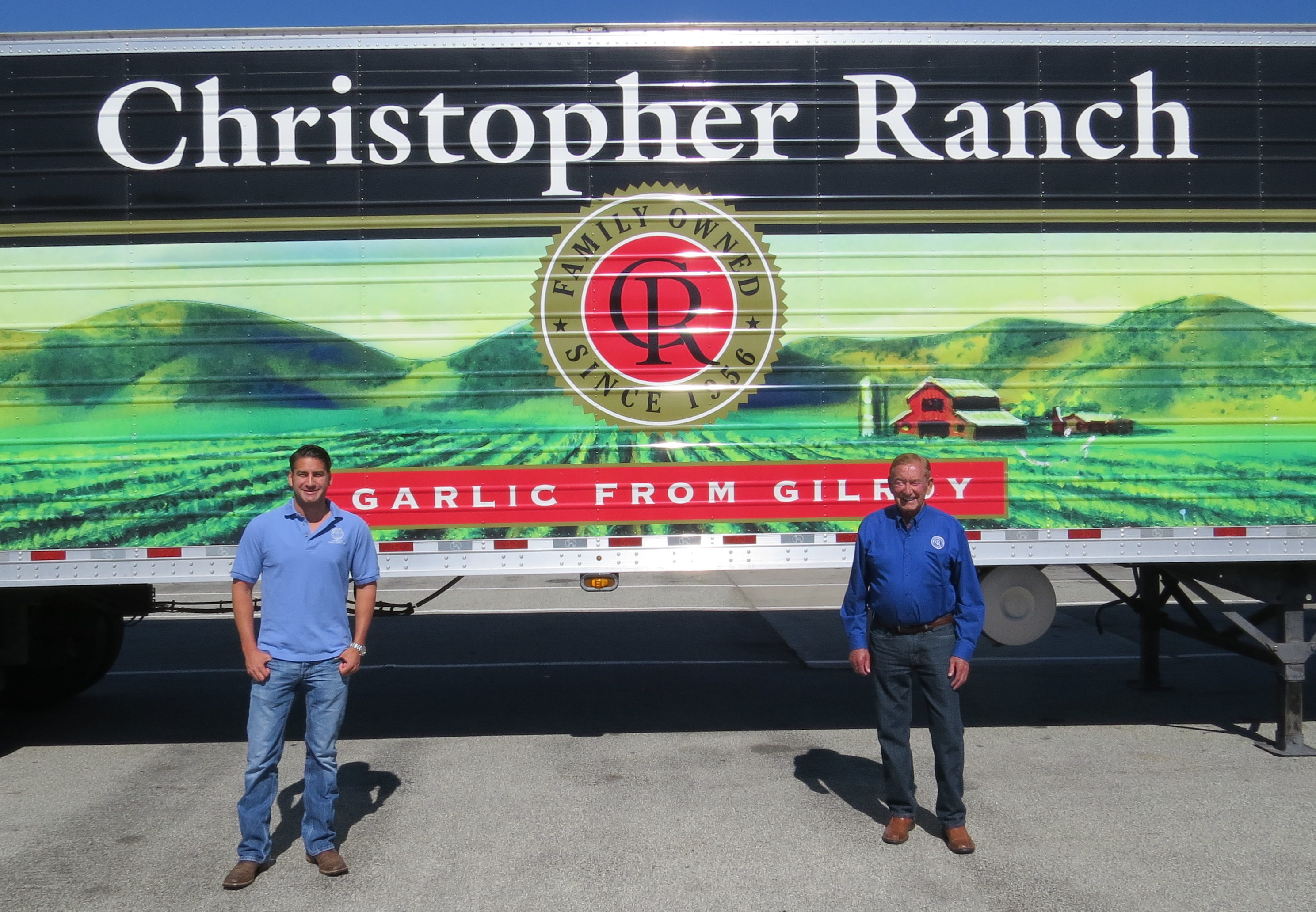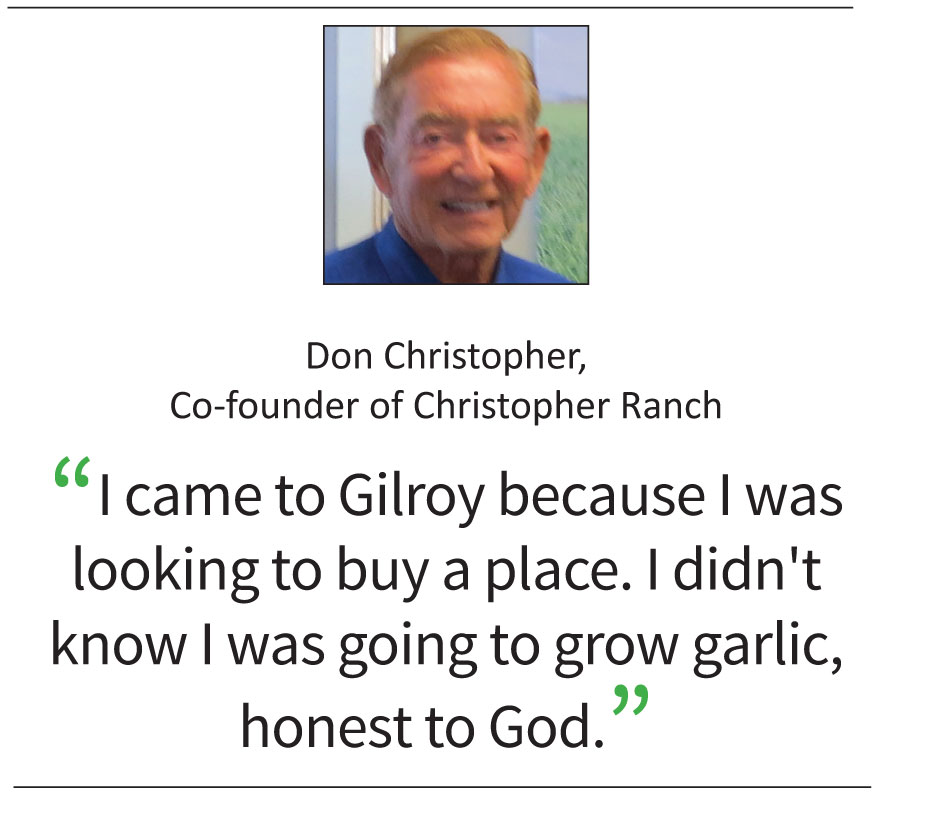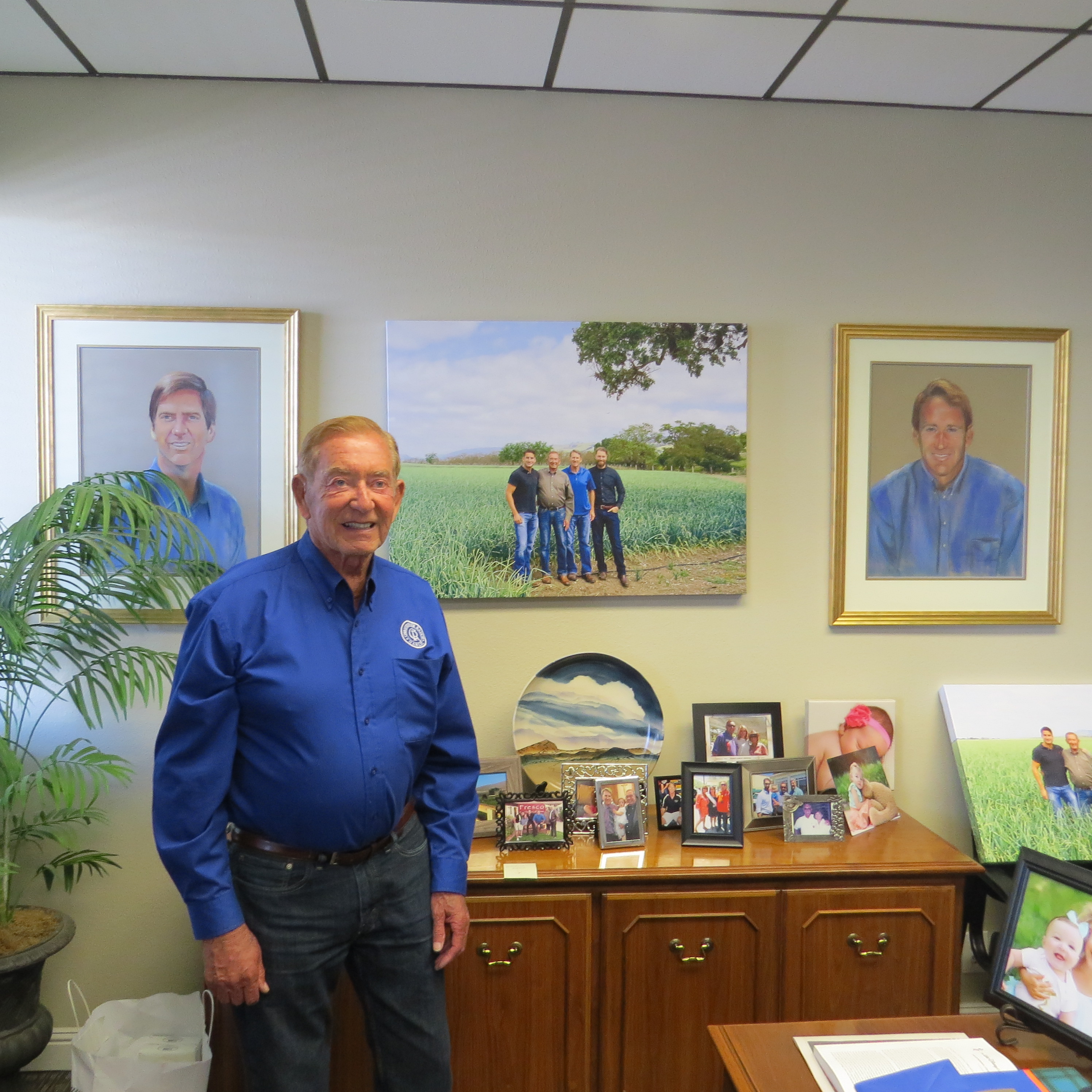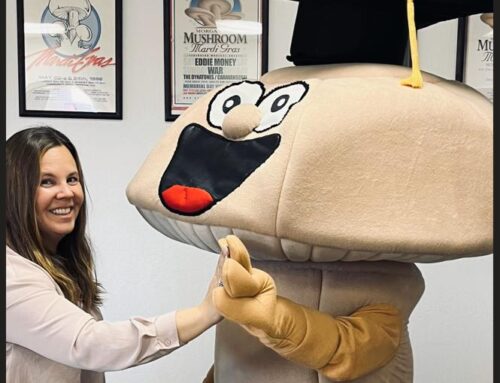Family supports local education, sports and many nonprofits
Published in the July 18 – July 31, 2018 issue of Morgan Hill Life
By Marty Cheek

Photo by Marty Cheek * Don Christopher, on the right, and his grandson, Ken Christopher.
When Ole Christopher arrived in Santa Clara County from Denmark, he set in motion a family farming tradition that nearly 90 years later led to the creation of the Gilroy Garlic Festival, which celebrates 40 years July 27-29. Today, many of his descendants contribute to Gilroy’s quality of life through the Christopher family’s generous support of local education, sports and nonprofits.
Ole’s grandson Don Christopher, 83, now serves as the family patriarch. He co-founded Christopher Ranch with his brother, Art Christopher, in 1956. Since then, the farm has grown into America’s top garlic producer.
The company’s headquarters and processing/refrigeration operations are reached by driving a long road through a cherry orchard located off Bloomfield Avenue southeast of Gilroy. On a June morning Don relaxed behind his office desk to chat, along with his grandson, Ken Christopher, about the family’s history and the impact its philanthropy has had on the South Valley region.
Impressed with the dark fertile soil of an area then called the Valley of Hearts Delight, the immigrant Ole settled near San Jose in the early 1890s and married a woman named Mary. Of strong Nordic stock, the young man began a business bailing hay because that was the only farming he knew about.
 “He got some Danes and Swedes to come work for him,” Don said of his great grandfather’s experience making a new life in California. “And then Mary would come out with food and water for the crew. That’s what happened for the first few years. And then he bought a prune orchard. It was nine acres over in south San Jose.”
“He got some Danes and Swedes to come work for him,” Don said of his great grandfather’s experience making a new life in California. “And then Mary would come out with food and water for the crew. That’s what happened for the first few years. And then he bought a prune orchard. It was nine acres over in south San Jose.”
With a little luck and a lot of hard work, Ole’s fruit farm grew to spread across 90 acres. He and Mary had several boys who helped with the farm work. When they became adults, he made a deal with them.
“He wanted to retire when he was young, I think he was 45,” Don said, recalling the family history. “He called his four sons to come in and he said, ‘You boys are going to run the ranch. And you’re going to pay me.’ I think it was 40 percent. And they said, ‘OK, daddy.’ They took over what he had and started buying property next to it and kept on growing.”
The Christopher Brothers farming enterprise grew over the years by adding more tracts of land until the family was one of the largest growers of prunes in the county. Don Christopher grew up on that ranch.

Photo by Marty Cheek * Gilroy Garlic Festival co-founder Don Christopher in his office.
As a boy and teenager, he worked with his father and uncles in the orchard, developing a love of the land and a farmer’s work ethic. As a young man of 22, he had enough of prunes and decided to strike off on his own.
The Valley of Hearts Delight was transforming into Silicon Valley, thanks in part to IBM’s building a high-tech complex off Cottle Road on land once covered with thousands of prune trees. San Jose’s population was growing with Baby Boomer families. Property values were rising.
“I came to Gilroy because I was looking to buy a place. I didn’t know I was going to grow garlic, honest to God,” Don said. “I saw a piece of property that was down here that my dad said to buy. And then I saw this one, and I said, ‘No, dad, I got to buy this one.’”
At $1,100 an acre, the price seemed steep in 1956. But Don and his brother, Art Christopher, bought the 13-acre farm property. (Art today remains a silent partner in Christopher Ranch’s business. He lives in Los Gatos.)
“The neighbors were all pissed off,” Don recalled. “They said, ‘How come you’re coming in with all this money, you people from San Jose?’ And I said, ‘We couldn’t buy any cheaper.’”
The man who sold it to Don gave him a deal of five years with no interest on the payment. He told Don with pride: “Young man, I’m glad someone is coming in who wants to be a farmer.”
 Surrounding Gilroy were about 20 garlic farms, most of them small operations. The biggest in the area was Gubser Farms, then the largest garlic producer in the United States. Joseph Gubser, Jr., purchased garlic grown from the South Valley farms.
Surrounding Gilroy were about 20 garlic farms, most of them small operations. The biggest in the area was Gubser Farms, then the largest garlic producer in the United States. Joseph Gubser, Jr., purchased garlic grown from the South Valley farms.
“He would furnish the seed and we’d plant it and he’d get the garlic for a certain price like 10 cents a pound,” Don said.
Eventually, Christopher Ranch started growing its own garlic seed in Nevada. As it got bigger, it went to Oregon where it was easier to farm. Don and Art planted French and Italian varieties of garlic that were the most flavorful they could find. One variety had been cultivated in Italy for centuries, originating in the Piedmont area. Called Monviso. It became Christopher Ranch’s signature garlic product. Christopher Ranch has nurtured its Monviso heirloom seed line for more than half a century to preserve its flavor.

Ken Christopher with his grandfather Don Christopher in a garlic field.
This year the family business is growing garlic on row crops covering about 5,500 acres. It has operations in Los Angeles, Chicago, New Jersey and Florida. Christopher Ranch has built a name for the quality of its products, which include not just raw garlic but garlic in jars and roasted garlic. It recently started selling vacuum-packed garlic which stores longer. Beyond American borders, it sells in Canada and Japanese Costco stores. Many family members participate in the business. Don’s son and Ken’s father, Bill Christopher, earned a bachelor’s degree in economics at Stanford University and used the knowledge to take the garlic grower to new levels of production, processing and marketing.
“We’re on track to do 100 million pounds for the first time in decades, which is really exciting,” Ken said proudly.
Don grinned. “I told someone that the other day and they about died,” he said.
“My grandfather built the company little by little,” Ken said. “He got really into vertical integration in the ‘80s. That’s when we started peeling our own garlic, roasting our own garlic, doing garlic jars — pesto and pickled — and really expanding the product line.”
Many Americans in the 20th century saw garlic as an exotic ingredient better suited for restaurants than their kitchens. Although it was a staple of Italian dishes, it was not widely used by home chefs. That started to change when Rudy Melone, the president of Gavilan Community College in the late 1970s, read a newspaper story about a garlic soup festival in the town of Arleux, France. It gave Melone an idea to promote the local garlic industry to a wider audience. He approached Don and Val Filice, a renown local chef, to see if they could bring media attention Gilroy and its “stinking rose” industry.
“He didn’t talk about a garlic festival at the time,” Don said. “He wanted to have a party at the ranch here and invite everyone involved with garlic — the growers, some of the buyers and some of the people from Los Angeles such as the food writers.”
The year 1978, the “unofficial first garlic festival” was launched.
“We were trying to create more awareness about garlic because back then consumption was a fraction of what it is now,” Ken said. “It was largely regulated to just Mediterranean cuisine. Now it’s a staple for many, many dishes.”
The next year, the official first Gilroy Garlic Festival took place on the Bloomfield Ranch property on the west side of U.S. 101 south of Gilroy. Filice as chef created a menu of garlicky foods, many of which have become staples of Gourmet Alley. The organizers estimated about 5,000 people would attend the weekend event. They were shocked when people kept coming and coming far beyond that number.
They figure about 15,000 showed up to the two-day festival. With triple the expected turnout, volunteers had to rush to Monterey and San Francisco to buy prawns and other ingredients. They recycled tickets because they hadn’t printed enough for the deluge of garlic-loving guests.
Several residents lived on the home located on the ranch. They were shocked when thousands of people started pouring onto the property, Don said with a laugh.
“Rudy Melone was the best negotiator you’ve ever heard,” he said. “And he goes and talks to them and gets them a couple of free tickets. And all of a sudden, they welcome us.”
The Gavilan president couldn’t sweet-talk his way out of a dilemma with Santa Clara County inspection officials, however.
“They said we should not be on that property because there’s no water, no running toilets, no facilities,” Don recalled “‘You guys have got to look elsewhere.’ And so, we looked and saw that Gilroy has a park and it’s big enough to handle the Garlic Festival. And so, we moved in.”
The festival in 1980 moved to Christmas Hill Park on the west side of Gilroy. In three years, the event grew so popular that it brought in more than 100,000 ticket-buying attendees. Hollywood actor Danny Kaye, a popular entertainer who also was an expert chef, showed up and helped with the cooking in Gourmet Alley. His fame brought media attention to the festival, helping it grow.
“Most people didn’t think it was going to go,” Don said of the festival’s initial reaction by Gilroy leaders.
Even the Gilroy mayor at that time told Don that a garlic festival was a crazy idea and no one would show. But the public proved the nay-sayers wrong. The festival added a Friday to the event because the weekend couldn’t handle the large crowds.
“We caught hell for that too. It’s on a Friday. The working man can’t come in on Friday,” Don said.
“Once you see more than 100,000 people celebrating garlic over a three-day weekend, your perspective starts to shift,” Ken said. “You realize that you’re onto something.”
The Gilroy Garlic Festival’s reputation has since grown beyond the city’s boundary and is now a “South County celebration,” he added.
In 40 years, it has raised more than $11.5 million to fund school programs and nonprofit organizations. Each year, 4,000 volunteers get “paid” for the hours they spend helping out at the festival. Among the most popular volunteer activities is preparing the nonstop flow of garlicky dishes under the massive Gourmet Alley food tent.
Every year, Christopher Ranch donates two tons of garlic that’s used at the festival. The grower also sponsored popular culinary stars of TV food shows such as Giada De Laurentiis who entertained a standing-room-only audience at the Cook-off Stage at the 2017 festival. This year, Christopher Ranch is sponsoring Master Chef Season 7 winner Shaun O’Neal, Olympic champion Brian Boitano and Iron Chef Michael Symon.
Beyond the festival, the Christopher family keeps active helping the Gilroy community in many other philanthropic ways, including education and the support of local youth. They donated 10 acres of land on the west side of the city to the Gilroy Unified School District for the Christopher High School campus, named it to honor the family.
The Don Christopher Sports Complex contributes to helping children and teens stay physically active. Nonprofits supported by the family include Unravel, which helps children with cancer, the Gilroy Compassion Center and the St. Joseph Family Center. Recently, the family worked with the Epilepsy Center of California to help children with this condition “be normal kids for one day” by picking cherries in the orchard and enjoying an outing at Gilroy Gardens Theme Park on Hecker Pass, Don said.
Ole Christopher’s immigrating to Santa Clara County proved to be more momentous than the Dane might have ever dreamed. The family that bears his last name have created a lasting legacy in the South Valley region that goes beyond garlic and the world’s most famous food festival. But locals will always associate Christopher Ranch and the family who runs it with Gilroy’s fame as the “Garlic Capitol of the World.”
“The festival builds a sense of community and volunteerism from the beginning. It’s something that’s really unique to Gilroy,” Ken said. “And then for us as Christopher Ranch, the Gilroy Garlic Festival is a critical part of our identity. We’re synonymous with Gilroy and the Garlic Fest. Those three things go hand in hand. We want to see this thing go on for another 40 years at least.”






